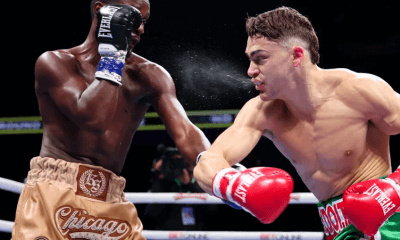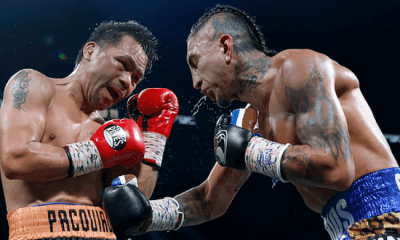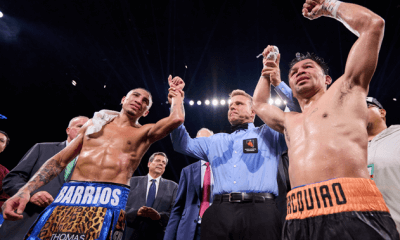Articles of 2009
Sun Rising Again Above The Blue Horizon
They come, frequently unannounced and unexpected, like pilgrims to a holy place. The most recent batch was from England, tourists who had come to Philadelphia ostensibly to soak in the rich history of the city and the area, which includes Independence Hall, the Liberty Bell, Valley Forge and all manner of landmarks associated with inventor/statesman Benjamin Franklin. But these Britons were also fight fans, so no visit to the city of Rocky Balboa, Joe Frazier and Bernard Hopkins would be complete without a side trip to a mansion constructed in 1865 that for nearly a hundred years had nothing to do with the sport with which it is now permanently linked.
The first professional boxing card at what is now known as the Blue Horizon was staged in 1961, which doesn’t seem so very long ago when measured against other, longer-vested shrines to the sweet science. But the Brits – not to mention Germans, Italians, Japanese and regular Americans from nearly every state – arrive to see for themselves if this hallowed hall, spiffied up a bit in recent years but still showing its age, is all that they have built it up to be in their minds.
Folks who like a good scrap do tend to become curious when no less an authority than The Ring magazine proclaim boxing’s most famous club venue as the absolute best place in the world to watch a prizefight.
“These English people came by and said they just had to take a look inside, at where the ring would be,” Vernoca Michael, principal owner of the Blue Horizon, said of the visitors who had crossed an ocean to soak in the atmosphere enriched by the memories of a thousand fights and fighters. “They said they had heard so much about this place, they just had to see it for themselves.”
Empty, during daylight hours and without the ring set up in its second-floor main room, the Blue Horizon might not seem so special. The neighborhood isn’t quite as high-crime as more perilous sections of Philadelphia, but it is hardly risk-free, especially after the sun goes down. On fight nights, when 1,200 patrons pack the place, parking is at a premium. Lines for the two bathrooms – one for men, one for women – are long, as are those for the single concession stand. There is heating during the winter, but no climate control during the summer months, when fans are obliged to endure steam-bath conditions.
Once, upon scoring a unanimous, 10-round decision over an equally gassed Miguel Santana in oppressive heat, welterweight “Rockin’” Rodney Moore was asked by a eager, young radio reporter for a local black station if he had any advice for the kids of North Philadelphia.
Moore, whose record 23 appearances there earned him the sobriquet of “King of the Blue Horizon,” gasped for air before responding.
“Yeah, I do,” Moore finally declared. “Never fight in an un-air-conditioned building in August.”
The next day’s hammer headline in the Philadelphia Daily News detailing Moore’s victory simply read, “Swelterweights.”
Outsiders might wonder how such an old mausoleum of a building, with outdated facilities and without even its own parking lot, can command such awe. But only those who have actually watched boxing at the Blue Horizon, be it from the overhanging balconies that are nearly on top of the action or from folding chairs around the ring, can speak to the incomparable sight lines. To watch a fight at the Blue is almost akin to being inside the ropes yourself. The mystique envelops you, takes you back to a time when the blood and sweat of so many fighters consecrated sites like this and gave them meaning. But Miami Beach’s 5th Street Gym, where a young Cassius Clay prepared to slay the dragon that was Sonny Liston, has fallen to the wrecking ball, and Los Angeles’ Olympic Auditorium has been converted into a Korean church.
Nor is Philly, a city that prides itself as the unofficial capitol of American boxing, been spared from history’s eraser. So much of Philadelphia’s sports heritage is being stripped away, layer by layer. The Spectrum – which was the site of so many great fights involving the likes of hometown heroes Frazier, Bennie Briscoe, Bobby “Boogaloo” Watts, Eugene “Cyclone” Hart, Willie “The Worm” Monroe and Stanley “Kitten” Hayward and such distinguished imports as Marvelous Marvin Hagler, Roberto Duran, Ernie Terrell and Mike Tyson, is being torn down later this year to make way for a hotel, retail stores and restaurants. Other club sites such as the Alhambra – affectionately known as the “Bucket of Blood” – and the Arena have been lost within the annals of time, sacrificed upon the supposed altar of progress.
Even the New Alhambra, the renamed Viking Hall in South Philadelphia that for the past five years has been the home of fight cards co-promoted by J Russell Peltz and the Hands, Joe Sr. and Joe Jr., is braced for a makeover that apparently won’t include boxing. The building’s owners, in effect, have evicted its tenants, who were not prepared to pay a demanded increase in rent from $1,000 to $6,000 a month. In the space which once housed pro cards, the Eastern Pennsylvania Golden Gloves tournament and the Joe Hand Boxing Gym soon will emerge a health club whose parent company is prepared to pay the much higher rent.
“To stay there and not own the building would have been foolish on my part,” said Joe Hand Sr., one of the original investors in Cloverlay, which bankrolled Joe Frazier during the early stages of his professional career.
The Hands are in the process of purchasing a building in the Northern Liberties section of Philly to house their gym, which should be good news to everyone who does not wish to see boxing at the local level perish in stages. But the turn of events that likely has doomed the sport at the New Alhambra is not entirely bleak for fight fans who will soon be treated to a more heaping dose of Blue Horizon fisticuffs than they’ve experienced in, well, years.
An arrangement is in place – contracts have not yet been signed, but are in the process of being drawn up – by which the Hands and Peltz will stage six fight cards at the Blue Horizon throughout the remainder of 2009, in addition to the Eastern Pennsylvania Golden Gloves. In conjunction with the bimonthly cards put on by Vernoca Michael’s company, The Legendary Blue Horizon Promotions, the bottom line is that there will be at least one show a month, and sometimes more, at the place that has proved to be such a tourist magnet even when fewer boxing events were presented there.
Don Elbaum, who serves as Michael’s matchmaker, said more in this instance is better … a lot better, in fact.
“Running 12 shows a year at the Blue Horizon is a plus not only for the Blue Horizon, but boxing and Philadelphia,” Elbaum said. “We are going to help Joe and Russell, and they are going to help us. No question.”
The new embarrassment of riches begins on Feb. 6, when Israeli soldiers Ran Nakash and Elad Shmouel headline the card promoted by Michael. Nakash (16-0, 12 KOs), who will be making his seventh appearance at the Blue Horizon, takes on Ryan Carroll (7-1, 4 KOs), of Delaware, Ohio, in the eight-round main event while Shmouel (18-2, 12 KOs), a junior welterweight, swaps punches with Khristian Garaci (4-5-1, 2 KOs), in a six-rounder.
Nakash serves as the chief instructor of hand-to-hand combat for the Israeli Defense Force; Shmouel is a first sergeant.
Exactly one month later, on March 6, the Hands and Peltz settle in when NABF welterweight champion Mike Jones (16-0, 14 KOs) defends his title against an opponent to be announced.
For Peltz, who has been running fight cards in Philadelphia since 1969, the return to the Blue Horizon is something of a homecoming. Since he had a falling out with Michael and moved on at the end of 2001, he has staged only one show there, a co-promotion with Don Chargin in January 2004. Until he partnered up with the Hands, he had been something of a gypsy in his own town, staging one-and-done shows at Poor Henry’s Brewery in 2000 and the Gershman YMCA (which for boxing purposes he renamed the Arts Palace) in 2002.
“It’ll be a little bit strange at first,” Peltz said of his return to once-familiar surroundings. “But as long as the fights are good, we’ll be fine.”
The friction between Peltz and Michael stemmed from Peltz’s complaints that improvements needed to be made to the facility. At the time, he cited unsafe catwalks and more minor concerns, such as peeling paint.
Those concerns were not without cause. In the summer of 2000, the Blue Horizon – so named by then-owner Jimmy Toppi in 1961, after a 1940s song, “Beyond the Blue Horizon” – was so decrepit that Philadelphia’s Department of Licenses and Inspections had cited it for fire and electrical code violations.
Michael and her business partner, Carol Ray, had quit their jobs and went into debt for $500,000 when they purchased the Blue Horizon in 1994. At the time, they anticipated receiving state funds allocated for improvements along the so-called Avenue of the Arts.
“The enticement for us buying the property was those state and city grants,” Michael said at the time. “But to date that money has not been forthcoming.
“We do have a `Save the Blue Horizon’ campaign going on, but it’s going slow, real slow. We need help. We have to stop putting band-aids on things that need major attention. Instead of patching that little piece of concrete, if you took the whole step out and fixed it properly, then it’s there for maybe the next 50 years.”
Although $2 million in state money eventually was made available (all of which was funneled into restoration projects), matching funds from the city never came through during the terms of Mayors Ed Rendell and John Street because of what Michael cited as confusion regarding tax-exempt issues.
So the Blue Horizon is only part of the way back to its turn-of-the-century (that would be the 20th century, not the 21st century) glory, although more work needs to be done. But the toilets flush, the place has gotten a fresh coat of paint and a nice outdoor electronic sign. Call it incremental advancement.
Most important, boxing – which constitutes only part of the ownership group’s operation, which includes a travel agency and education programs – is likely to remain the most obvious part of the building’s identity.
Peltz and Michael are prepared to let bygones be bygones. “I’m a businesswoman, and business is business,” Michael reasoned, a theme echoed by Peltz as each sought to ease a potentially uncomfortable situation.
Several of the fighters promoted by Peltz and the Hands, including Jones and super bantamweight Teon Kennedy, are unabashedly looking forward to making their Blue Horizon debuts after fighting most often as pros at the New Alhambra. They’re Philly fighters who know the city’s rich boxing history, and much of that history is rooted in the onetime Fraternal Order of Moose lodge hall on North Broad Street.
For one man’s opinion of what the Blue Horizon represents, consider these words from Eric “Butterbean” Esch, the heavyweight novelty act who scored a first-round knockout of Tim Pollard on Aug. 25, 1998, which ended the 17-year run of “Tuesday Night Fights” on the USA Network.
“The Blue Horizon, to me, is like Madison Square Garden,” Butterbean opined. “It’s a famous fight site. You know you’re making it as a fighter if you fight at the Blue.”
And if you don’t believe Butterbean, maybe you’ll agree with Arizona Senator John McCain, the recent Republic nominee for President of the United States who was at ringside for Butterbean-Pollard as a guest of then-Pennsylvania Gov. Tom Ridge.
“It’s my first time here, but I’ve seen the place on television a hundred times,” said McCain, a former Naval Academy boxer. “I’d heard about the incredible atmosphere, and everything I’ve heard is true. This is one of the great, classic places for boxing.”
-

 Featured Articles3 weeks ago
Featured Articles3 weeks agoResults and Recaps from New York Where Taylor Edged Serrano Once Again
-

 Featured Articles1 week ago
Featured Articles1 week agoThe Hauser Report: Zayas-Garcia, Pacquiao, Usyk, and the NYSAC
-

 Featured Articles2 days ago
Featured Articles2 days agoOscar Duarte and Regis Prograis Prevail on an Action-Packed Fight Card in Chicago
-

 Featured Articles3 weeks ago
Featured Articles3 weeks agoResults and Recaps from NYC where Hamzah Sheeraz was Spectacular
-

 Featured Articles4 weeks ago
Featured Articles4 weeks agoFrom a Sympathetic Figure to a Pariah: The Travails of Julio Cesar Chavez Jr
-

 Featured Articles2 weeks ago
Featured Articles2 weeks agoManny Pacquiao and Mario Barrios Fight to a Draw; Fundora stops Tim Tszyu
-

 Featured Articles4 weeks ago
Featured Articles4 weeks agoPhiladelphia Welterweight Gil Turner, a Phenom, Now Rests in an Unmarked Grave
-

 Featured Articles2 weeks ago
Featured Articles2 weeks agoArne’s Almanac: Pacquiao-Barrios Redux
















